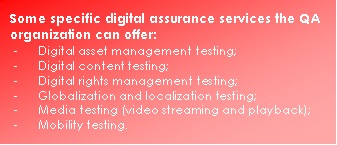KEY THEMES FOR QA U0026AMP; TESTING ORGANIZATIONS TO FOCUS ON DURING DIGITAL TRANSFORMATION
April 30, 2015

In my previous blog post Quality-driven Digital Transformation, I had explained why the role of QA&Testing is vital in certifying Digital Transformations. To fulfill its critical role in a Digital Transformation journey, QA&Testing organizations must focus on some key themes.
Key theme 1: Customer Experience & Customer Journey
During your Digital Transformation journey, every decision you make should factor in both of these important aspects – Customer Experience & Customer Journey. At the beginning of your journey, you have to ask yourself: how can you support the growing digital needs of the business?
According to the Altimeter Group Digital Transformation Survey 2014[1]: “Those companies that are formally undergoing digital transformation efforts, the consensus is clear: everything is focused on ultimately enhancing the digital customer experience.”
In the new digital world, users expect a high quality, seamless digital customer experience. Looking into digital behaviors and touchpoints of your customers helps you succeed by learning where and how to introduce value into the entire customer chain.more–>
Westfield Shopping Centres is doing just that with Westfield Labs.[2] According to Andy Hedges, Director of  Shopping Center Management and Marketing at Westfield: “A lot of work Labs is doing is focused on understanding the shopper, the actual consumer, relationship with the brand, which is something that we’ve had very little engagement with at this point,” Hedges shared. He continued, “In Westfield’s context, it’s about how we facilitate the ability for any kind of engagement, anywhere, anytime, anyway. ‘Shop my way.’ The role that digital transformation plays in that is, how do facilities enhance the ‘shop my way’ capability?”
Shopping Center Management and Marketing at Westfield: “A lot of work Labs is doing is focused on understanding the shopper, the actual consumer, relationship with the brand, which is something that we’ve had very little engagement with at this point,” Hedges shared. He continued, “In Westfield’s context, it’s about how we facilitate the ability for any kind of engagement, anywhere, anytime, anyway. ‘Shop my way.’ The role that digital transformation plays in that is, how do facilities enhance the ‘shop my way’ capability?”
This key theme should be placed at the heart of your Digital Transformation journey by focusing on assuring improved customer experience to positively influence business Key Performance Indicators (KPIs) through Quality Assurance. QA organizations must ensure a complete customer experience, in addition to ensuring high quality products and services. This will create confidence in the business.
Key theme 2: Cyber Security
As part of the Digital Transformation journey, SMACT makes the enterprise more vulnerable and easier to attack for cyber criminals. This clarifies the importance of Cyber Security during your Digital Transformation. It’s absolutely critical to protect your assets and resources in this new digital landscape. Start thinking and acting to secure your business from the beginning of your Digital Transformation journey. This is necessary to ensure that during and after the transformation, your business remains resilient. Define which risks are acceptable and which are not, so you can choose the right protective measure to prevent the unacceptable risks.
Define
These are some questions you have to answer from the beginning of your Digital Transformation journey:
- Is it possible to combine digital transformation with acceptable risks?
- How secure are our website, apps, data centers and data?
- How to transform our current practices to manage increasing threats?
Taking Cyber Security assessments and audits will help you to define the secured and right strategy and transformation program.
Protect
The next step is protecting your systems with Security Assurance and Testing. Doing this in an effective way provides you the ability to strengthen your applications, your infrastructures and end-points.
Secure lifecycle management processes and security testing enable you to verify whether your systems are secure. Using a proven testing approach across infrastructure and applications (enterprise, web, mobile and Internet of Things) improves security for new offers and solutions.
This will give you the confidence to adopt SMACT technologies during and after your Digital Transformation journey.
Key theme 3: Omni-channel
The ultimate goal for companies is to ensure a truly consistent experience across all channels of interaction. Both the physical  channels (stores) and digital channels (phones, wearables,…) should provide the user a connected and consistent set of features.
channels (stores) and digital channels (phones, wearables,…) should provide the user a connected and consistent set of features.
The QA organization should focus on optimizing functional testing across channels. It should be done by using test scenarios spread across all-channels and simulating real user behavior, which are more effective and efficient.
This clarifies the real meaning of Omni-channel testing. Testing across channels is not Omni-channel testing. Designing a test strategy with a view of all the channels and real user behavior is!
We can point two important aspects of Omni-channel testing:
- Multiple devices: Applications need to be made available in every category of devices (phone, tablet, notebooks, wearables) and should provide a seamless customer experience. QA organizations can use test automation for repeated tests on various devices.
- Multiple platforms: It is important to test all possible browsers and operating system stacks, but it is also necessary to optimize testing across these combinations.
Key theme 4: Digital Assurance Platform
In order to fulfill its critical role during Digital Transformation, a QA organization should have a comprehensive Digital Assurance platform. It should also provide a set of re-usable assets and enablers, which can improve the efficiency of Quality Assurance and Testing processes. The platform must cover the entire digital value chain, beginning with content creation, development, manufacturing, marketing, distribution and delivery.
These are some characteristics that your Digital Assurance platform must have:
- Provide LEAN assurance methodologies and early defect detection to reduce and eliminate defects at the source, mitigate risks and decrease costs. Sogetis PointZERO® vision can help you with this.
- Provide new test methodologies that transform the role of QA organizations to the business assurance partner and the guardian of customer experience. These should be done by creating trust through build-in quality. Sogeti’s TMap® HD can help you with this.
- Provide a digital assurance strategy that includes industry-specific test solutions and methodologies to improve business confidence.
- Provide test automation tools and facilitate the adoption of the right tool sets across the entire content value chain.
- Adopt innovative visions, methodologies and approaches in QA&Testing.
These are the key themes, which a QA&Testing organization should focus on to fulfill its critical role in the Digital Transformation journey and to make the QA organization future ready.
[1] Brian Solis, The 2014 State of Digital Transformation, Altimeter Group, July 2014.
[2] “An entity of Westfield Corporation and serves as a global digital lab focused on innovating the retail ecosystem by leveraging the social, mobile and digital market opportunities that converge the digital shopper with the physical world.” Kevin McKenzie Global Chief Digital Officer.

 English | EN
English | EN 